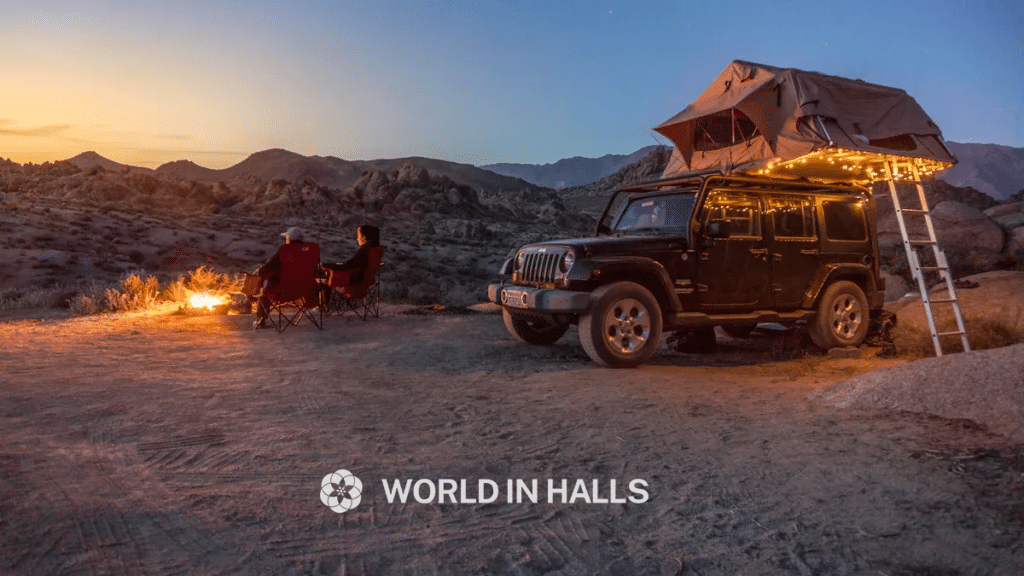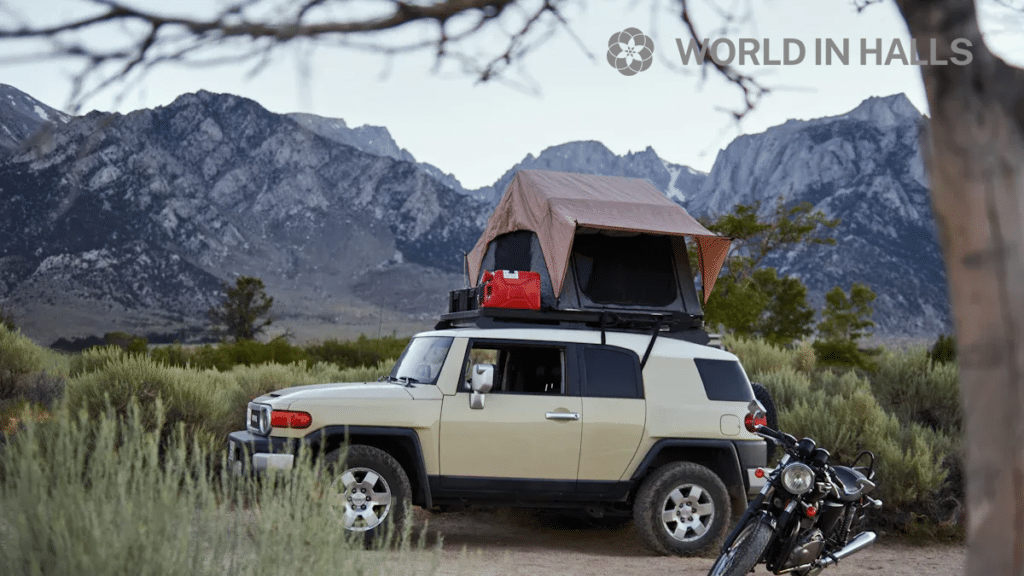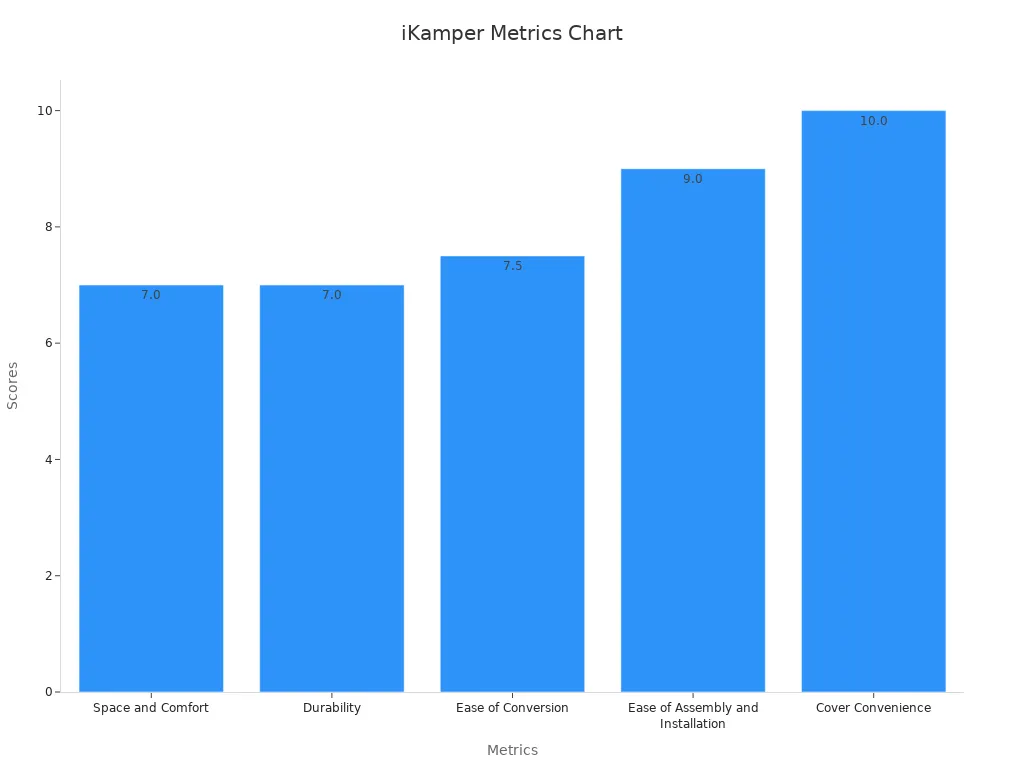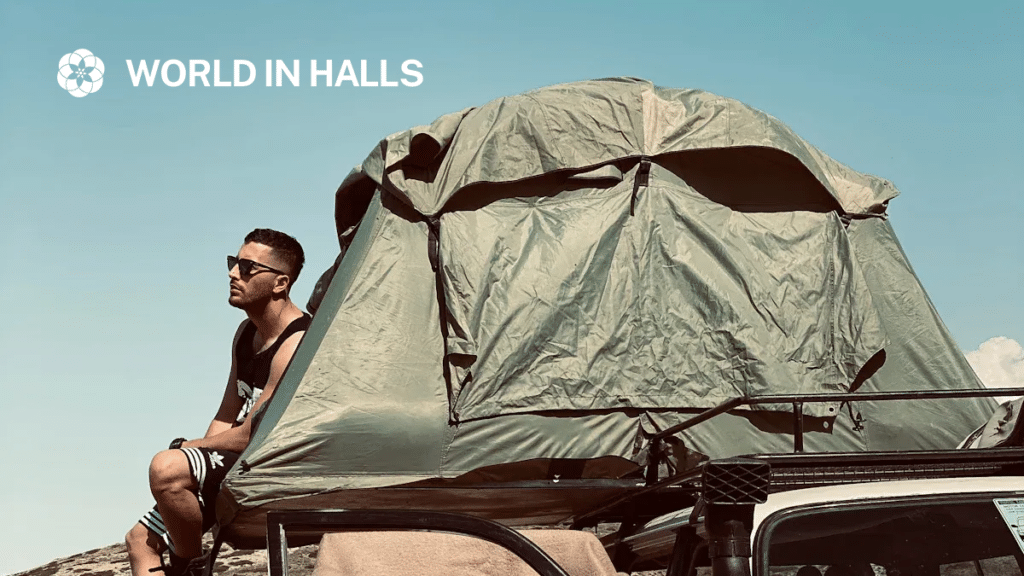
Rooftop tents are cherished by those who revel in the great outdoors. They provide an enjoyable way to connect with nature. As adventure tourism continues to flourish, these tents are gaining popularity, with the market projected to reach £1,626.7 billion by 2026. Approximately 70% of young adults now favour activities such as camping, indicating a growing enthusiasm for outdoor adventures.
Rooftop tents allow you to sleep safely above the ground, keeping you protected from animals and insects. They can be set up quickly in a variety of locations, making them ideal for thrilling excursions. Choosing the right rooftop tent ensures comfort and convenience. Be sure to view other rooftop tents from WORLDINHALLS for more options to enhance your camping experience.
Key Takeaways
Rooftop tents keep you safe by lifting you above insects and animals.
Check if your car can handle the tent’s weight before buying.
Compare hard-shell and softshell tents to pick what suits your camping style.
Look for extras like built-in beds and easy setup to make camping better.
Pick a rooftop tent that fits your budget and needs, from cheap to fancy ones.
Advantages and Disadvantages of Rooftop Tents
Rooftop tents are loved by outdoor lovers. They offer a fun way to enjoy nature. But, like all camping gear, they have good and bad points. Knowing these helps you decide wisely.
Advantages of Rooftop Tents
Safety and Security
Sleeping off the ground keeps you safe from animals and water. Unlike ground tents, rooftop tents lift you up, keeping bugs and small creatures away.Comfort and Warmth
Many people find rooftop tents warmer in cold weather. They often have thick materials and built-in mattresses for a snug sleep.Quick Setup
Hard-shell rooftop tents are easy to set up fast. In just a few steps, your tent is ready, saving time and effort.Space-Saving Benefits
You can store bedding inside the tent when not using it. This saves space in your car for other camping items.Versatility
These tents work in many places, like campsites or off-road spots. They suit different terrains and weather conditions.Panoramic Views
Many rooftop tents have big windows for great views. This lets you enjoy nature while staying cosy in your tent.
Disadvantages of Rooftop Tents
Higher Costs
Rooftop tents, especially hard-shell ones, cost more than ground tents. The benefits are great, but the price can be high.Impact on Fuel Economy
Rooftop tents add weight and wind drag to your car. This can lower fuel efficiency by 7-9%, especially on long trips.Mounting and Setup Challenges
Setting up a rooftop tent can be tricky for beginners. You might need help to attach it securely to your car roof.Limited Mobility
Once installed, the tent stays on your car. You can’t leave it behind when driving elsewhere, which may be inconvenient.Weather Sensitivity
Folding rooftop tents are less stable in strong winds or heavy rain. Hard-shell tents handle bad weather better.Insect Issues
Some tents have gaps that let bugs in. You might need extra netting to keep mosquitoes and insects out.
Tent Type | Advantages | Disadvantages |
|---|---|---|
Strong build, quick to set up | Costs more, less space inside | |
Folding | Cheaper, more room | Takes longer to set up, less weatherproof |
By looking at these pros and cons, you can decide if a rooftop tent is right for you. Whether you want safety, comfort, or ease, knowing these points will help you choose well.
Best Car Roof Top Tent of 2025

Picking the best rooftop tent can be tricky. There are many choices, so it’s hard to decide. To make it easier, here are three top models. They suit different budgets and needs.
Best for Families: WORLDINHALLS Car Roof Top Tent
The WORLDINHALLS Car Roof Top Tent is ideal for families. It’s roomy and makes camping trips easier and more fun.
Made with strong 300D Oxford cloth and aluminium, it’s built to last. The double-layer fabric keeps you dry during rain and cool on sunny days. The special anti-glare material adds extra comfort.
One of its best features is the hydraulic support rod. This lets you set it up quickly without much effort. It has one door and three windows for fresh air and great views.
The tent fits two kids comfortably(Maximum load-bearing capacity: 75KG). Its compact size (225 × 140 × 19 cm) makes it easy to carry. Weighing 80 kg, it stays steady on your car.
Note: Many users like that you can store bedding inside when not using the tent. This saves space in your car.
With a 5.00 out of 5 rating, this tent is loved by families. Whether you’re heading to the beach or the woods, the WORLDINHALLS Car Roof Top Tent ensures a safe and comfy trip.
Feature | Details |
|---|---|
Capacity | 2 children |
Material | 300D Oxford cloth, aluminium |
Setup Time | Quick with hydraulic support rod |
Ideal For | Family camping trips |
Note: Click here to view all rooftop tent products of worldinhalls. Register as our B2B member to enjoy lower prices.
Best Overall: iKamper Skycamp 3.0 Mini
The iKamper Skycamp 3.0 Mini is the best overall. It’s small, so it fits smaller cars well. Even though it’s compact, it’s still comfy and practical. The strong cotton-poly shell keeps water out. Big windows let you enjoy amazing views.
This tent is easy to set up and use. You’ll spend less time assembling and more time having fun. Inside, it’s roomy enough for two adults. It’s great for couples or solo travellers who want extra space.

Metric | Weight | Score |
|---|---|---|
Space and Comfort | 30% | 7.0 |
Durability | 25% | 7.0 |
Ease of Conversion | 20% | 7.5 |
Ease of Assembly and Installation | 15% | 9.0 |
Cover Convenience | 10% | 10.0 |
At £3,979, it’s a high-quality choice. If you want the best rooftop tent, this one is worth it.
Best Budget Option: Topoak Galaxy 1.0
The Topoak Galaxy 1.0 is the best budget pick. It costs £1,299 and gives great value. It’s simple to set up, so beginners will like it. Its light weight helps save fuel, which is a bonus.
This tent has a comfy mattress and strong materials. It’s affordable but still has all the important features. It’s ideal for first-time campers or anyone on a budget.
Price Range | Model Name | Key Features |
|---|---|---|
Budget (<£2,000) | Topoak Galaxy 1.0 | Easy setup, great feature set, £1,299 |
Best for Maximum Headroom: Roofnest Sparrow EYE 2
The Roofnest Sparrow EYE 2 is perfect if you need space. It has lots of headroom, so you can move easily inside. This is great for taller people or those who like open spaces.
It’s built to last and handles bad weather well. Big windows keep air flowing and show lovely views. At £2,995, it’s a mid-priced option with luxury features. Campers who want comfort and style will love it.
Price Range | Model Name | Key Features |
|---|---|---|
Mid-Tier (£2,000-£3,000) | Roofnest Sparrow EYE 2 | Maximum headroom, durable build, £2,995 |
These three tents are the best for 2025. Whether you want performance, savings, or space, there’s a tent for you.
Best Softshell Tent: Thule Approach M
The Thule Approach M is a great softshell tent. It’s light, so it’s easy to carry and use. Strong materials make it last in different weather. This tent is both useful and affordable, perfect for outdoor fans.
It has enough space for two adults to sleep comfortably. The softshell design keeps air flowing, making it cool on warm nights. Big windows let you enjoy lovely views while camping.
Setting it up is simple and quick, even for beginners. When folded, it’s small and easy to store, saving car space.
If you want a softshell tent that’s comfy, strong, and easy to use, pick the Thule Approach M. It’s great for short trips or long camping holidays.
Best for Three People: Yakima SkyRise HD
The Yakima SkyRise HD is perfect for small groups or families. It fits three people and gives plenty of room to sleep well. The thick foam mattress helps you wake up feeling fresh.
This tent is made with weatherproof materials for all climates. The rainfly and waterproof fabric keep you dry in rain. Mesh panels let air in and are great for stargazing at night.
It’s easy to attach to most cars with roof racks. Its light build means it won’t use much extra fuel. The strong design makes it a good pick for outdoor adventures.
If you need a tent with space, comfort, and weather protection, try the Yakima SkyRise HD. It’s ideal for families or friends who love camping together.
Best Four-Season Tent: Roofnest Falcon 3 EVO
The Roofnest Falcon 3 EVO is great for all-year camping. It handles tough weather like snow and heat. Its hard shell keeps you safe and comfy in any season.
Inside, it’s roomy and cosy with insulated walls. These keep you warm in winter and cool in summer. The built-in mattress makes it feel like home.
It’s quick to set up, so you can start your trip fast. Its shape cuts wind drag, helping your car save fuel.
For a tent that works in all seasons, choose the Roofnest Falcon 3 EVO. It’s strong, comfy, and versatile, perfect for serious campers.
Best for Overlanding: iKamper BDV Duo
The iKamper BDV Duo is perfect for overlanding adventures. It’s made for those who love exploring tough terrains. This rooftop tent is strong, comfy, and practical. Its sturdy build handles off-road challenges, making it a dependable travel partner.
The hard-shell design protects well against bad weather. Its smooth shape cuts wind drag, helping save fuel on long drives. Inside, it has enough space for two adults to rest comfortably after a busy day.
Setting up this tent is fast and easy. You can have it ready in just a few minutes. The built-in mattress adds comfort, so you wake up feeling energised for the day ahead.
Tip: Use a strong roof rack with the iKamper BDV Duo for better stability.
The tent has several vents to keep air flowing and stop moisture build-up. This is especially helpful in damp areas. With its top-quality materials and smart design, the iKamper BDV Duo is a great pick for overlanding fans.
Feature | Details |
|---|---|
Capacity | 2 adults |
Material | Hard-shell, weather-resistant |
Setup Time | Under 5 minutes |
Ideal For | Overlanding and off-road adventures |
Buyer’s Guide to Choosing the Perfect Rooftop Tent
Vehicle Compatibility
Picking a rooftop tent starts with checking your car’s fit. Not all tents suit every vehicle, so check carefully. First, look at the tent’s weight in the product details. This helps you know if your car and roof rack can hold it.
Your car’s dynamic weight capacity is very important. This is the weight your car and rack can carry while moving. Check your car manual to avoid overloading. Also, make sure your roof rack works with the tent. Some racks may not be stable enough for safe use.
Static weight capacity matters too. This is the weight your car roof and rack can hold when parked, including the tent and people inside. Always check these details before buying.
Tip: If unsure, ask an expert to check if your car suits the tent. This keeps your car safe and prevents damage.
Hardshell vs. Softshell Tents
There are two main types of rooftop tents: hardshell and softshell. Each type has its own benefits, so knowing the differences helps you choose wisely.
Hardshell tents are strong and easy to set up. Their tough build handles bad weather, making them great for all seasons. For example, tents like the Thule Approach have water-resistant covers to block rain and wind. But, hardshell tents are heavier and cost more.
Softshell tents are lighter and give more space. They often have vents to stop dampness, like in Thule Tepui tents. These are cheaper but need more effort to set up. If you want something light and affordable, softshell tents are a good choice.
Weight and Space Considerations
The tent’s weight affects your car’s fuel use and performance. Heavy tents add wind drag, lowering mileage. Lighter tents, like softshell ones, reduce this problem.
Space is also key. Think about how much room you’ll need inside. For family trips, pick bigger tents like the WORLDINHALLS Car Roof Top Tent. It fits two adults and two kids. For solo campers or couples, smaller tents like the iKamper Skycamp 3.0 Mini work well.
Note: Keeping bedding inside the tent when not in use saves car space and makes packing easier.
Balancing weight and space ensures your tent fits your needs without hurting your car’s performance.
Durability and Weather Resistance
Picking a strong rooftop tent is very important. A sturdy tent keeps you safe and comfy while camping. Look for tough materials like ripstop fabric or 300D Oxford cloth. These fabrics resist tearing and last longer. Aluminium or aviation-grade frames are strong but not too heavy.
Weather protection matters too. A good tent should handle rain, wind, and heat. Waterproof layers and double fabrics keep you dry in heavy rain. UV-resistant materials stop sun damage and fading. Mesh windows help air flow and reduce dampness in humid weather.
Tip: Check the tent’s weather rating. Four-season tents, like the Roofnest Falcon 3 EVO, work well in all climates.
Price and Value for Money
Rooftop tents come in many price ranges. Choose one that fits your budget and needs. Expensive tents, like the iKamper Skycamp 3.0 Mini, have great features and last long. Cheaper options, like the Topoak Galaxy 1.0, are simple but still useful.
Think about the tent’s lifespan and features when deciding. Spending more now can save money later if the tent lasts years. Look for extras like built-in mattresses or quick setup systems. These make camping easier and more enjoyable.
Note: Read reviews and check warranties to pick a reliable tent.
Additional Features to Look For
Extra features can make camping better. Hydraulic support rods, like in the WORLDINHALLS Car Roof Top Tent, make setup easy. Built-in bedding storage saves car space. Big windows give great views and improve airflow.
Some tents have LED lights or USB ports for convenience. Insulated walls and anti-glare fabrics add comfort in different weather. If camping in windy spots, choose tents with strong zippers and secure anchors.
Tip: Pick features that suit your camping style. Families may prefer bigger tents with more doors.
Installation and Setup Guide

Preparing Your Vehicle and Roof Rack
Before installing a rooftop tent, you must prepare your vehicle and roof rack. Start by checking the weight capacity of your roof rack. Ensure it can support the tent and the people who will sleep inside. Look at your car’s manual to confirm the dynamic and static weight limits.
Inspect the roof rack for stability. Tighten any loose bolts or screws to prevent movement during travel. If your rack is old or damaged, replace it with a sturdy one. A strong roof rack ensures the tent stays secure while you drive.
Clean the roof of your vehicle before installation. Dirt or debris can affect the tent’s grip and cause scratches. Use a soft cloth to wipe the surface. This step helps the tent attach to your vehicle safely and securely.
Tip: If you’re unsure about your roof rack’s compatibility, consult a professional for advice.
Step-by-Step Installation Process
Installing a rooftop tent involves several steps. Follow these instructions for a smooth and quick setup:
Install Mounting Rails
Remove the plugs from the tent’s base. Secure the bolts to attach the mounting rails. These rails connect the tent to your roof rack.Install Ladder
Attach the brackets for the ladder. Ensure they are tightened properly to allow safe use.Mount the Tent
Place the tent on your roof rack. Check the bolt lengths to ensure they fit your rack. Tighten the bolts evenly to keep the tent stable.Open the Tent
Use the ladder to partially open the rooftop tent. This step demonstrates how easy it is to set up.Install Travel Cover
Secure the travel cover over the tent. Handle it carefully to avoid damage.
These steps simplify the installation process and ensure the tent stays firmly attached to your vehicle.
Tips for Safe and Efficient Setup
Safety and efficiency are key when setting up a rooftop tent. Always work on a flat surface to prevent accidents. Avoid installing the tent in windy conditions, as this can make the process harder.
Use a ladder or step stool to reach the roof comfortably. This reduces strain and helps you work faster. Double-check all bolts and brackets after installation. Loose parts can cause the tent to shift while driving.
Store tools nearby for easy access during setup. Keep a checklist of the installation steps to avoid missing anything. A quick setup saves time and lets you enjoy your camping trip sooner.
Tip: Practice setting up the tent at home before your trip. This helps you become familiar with the process and reduces stress during travel.
Alternatives to Rooftop Tents
Rooftop tents are great, but other options might suit you better. Tailgate tents and truck bed tents are two popular choices. Each has features for different camping styles.
Tailgate Tents
Tailgate tents connect to your car’s boot, creating extra space. They are light and simple to set up, perfect for short trips. You can easily access your car while having a cosy sleeping area.
These tents are cheaper than rooftop tents, making them budget-friendly. They don’t add weight to your car’s roof, so fuel use stays normal. But they aren’t as strong in bad weather. Heavy rain or wind can make them less stable.
Tailgate tents are best for campers who like staying near their car. They also give extra storage, as you can keep gear in the boot while sleeping in the tent.
Truck Bed Tents
Truck bed tents fit into the back of a pickup truck. They lift you off the ground, keeping you safe from bugs and wet surfaces. These tents are great for truck owners who want a secure sleeping spot.
They are faster to set up than rooftop tents. You don’t need a roof rack, and they are lighter, which is easier on your car. However, taller people might find them a bit cramped because of limited height.
Truck bed tents are compact and easy to carry. They’re ideal for solo campers or couples who like simple camping. If you enjoy rough terrains, these tents are a dependable choice.
Tip: Think about your car type and camping style before choosing. Tailgate and truck bed tents have unique perks that might fit your needs better.
Rooftop tents are a fun way to camp outdoors. They mix safety, comfort, and ease. In 2022, the market was worth £177 million. By 2028, it may grow to £291 million. Younger people, like millennials and Gen Z, love these tents for exciting trips.
When picking a tent, think about your car, strength, and weatherproofing. The WORLDINHALLS Car Roof Top Tent is great for families. For solo campers, the iKamper Skycamp 3.0 Mini is a top choice. Setting up the tent properly keeps you safe and protects your car. Choosing the right tent makes camping more enjoyable and memorable.
FAQ
What is the lifespan of a rooftop tent?
Most rooftop tents last 5 to 10 years with proper care. Regularly clean the fabric and check for wear and tear. Store the tent in a dry place when not in use to extend its lifespan.
Can you install a rooftop tent on any car?
Not all cars can support rooftop tents. Check your vehicle’s dynamic and static weight capacities. Ensure your roof rack is compatible and sturdy enough to hold the tent securely.
How do you maintain a rooftop tent?
Clean the tent after each trip using mild soap and water. Inspect the zippers, seams, and fabric for damage. Lubricate moving parts like hinges and ladders. Store the tent in a cool, dry place to prevent mould.
Are rooftop tents safe in bad weather?
High-quality rooftop tents handle bad weather well. Look for waterproof materials, strong frames, and secure anchors. Avoid camping in extreme conditions like storms or heavy snow for safety.
Do rooftop tents affect fuel efficiency?
Yes, rooftop tents increase wind resistance and weight, reducing fuel efficiency by 7–9%. Choosing a lightweight tent and removing it when not in use can minimise this impact.



